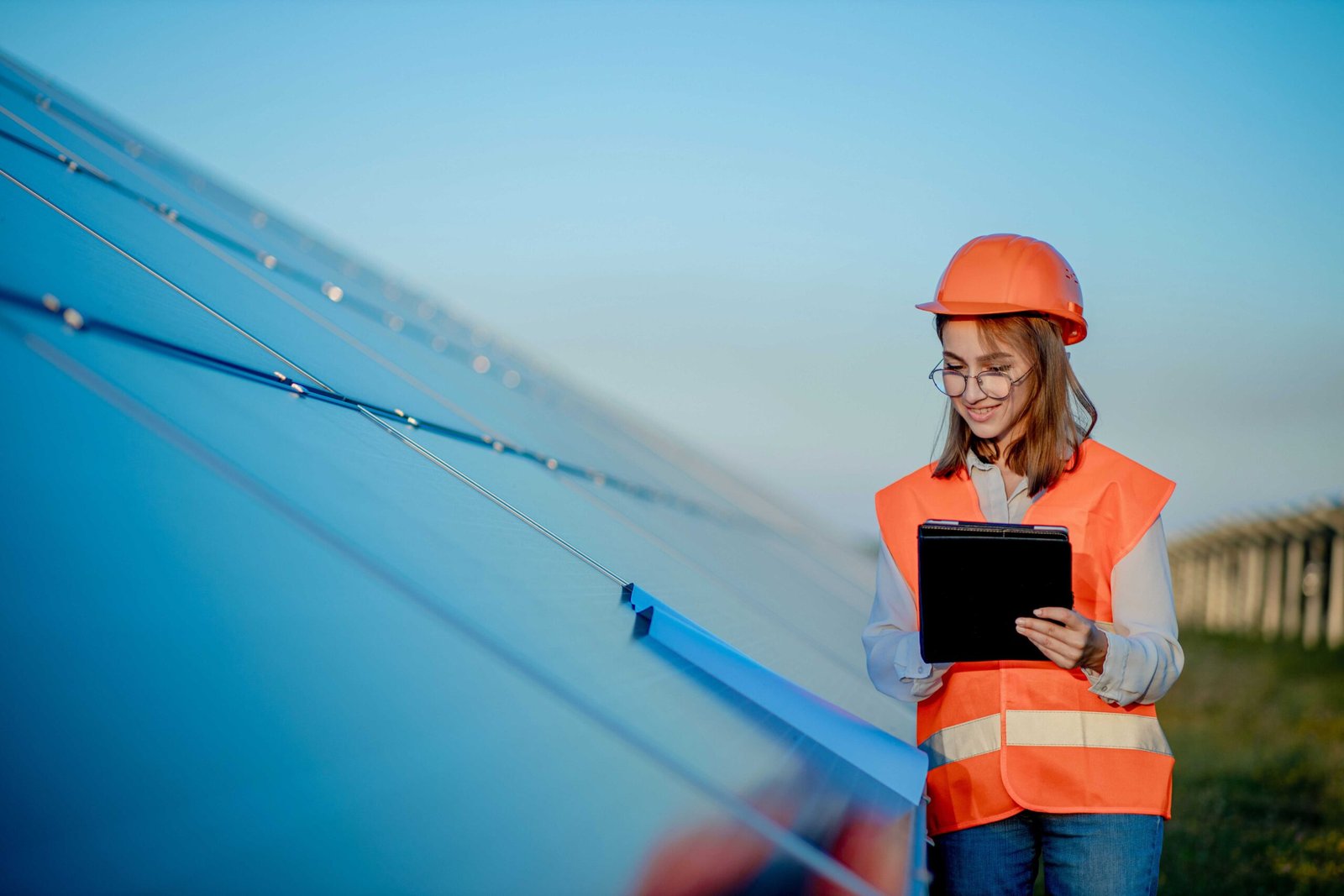Sun Powered Future: Insights from Hamro Solar LLC is a lighthouse of invention and promise. With sustainability front and foremost, Hamro Solar LLC has become a leader in solar technology development. It is not only edifying for sustainable tech enthusiasts, householders, and environmental activists, but also essential to comprehend the direction of solar energy. This blog post delves deeply into the future of solar technology, providing Hamro Solar with insights that enlighten the path to a more sustainable world. In the often shifting terrain of world energy, solar technologies are a lighthouse of invention and promise. Leading in the development of solar technology, Hamro Solar LLC has sustainability first in mind.
The Evolving Landscape of Solar Technology
Like the sunlight it exploits, Sun Powered Future: Insights from Hamro Solar LLC is fast changing. From improving efficiency to including artificial intelligence, the developments are as fascinating as they are powerful. Leading the way, Hamro Solar LLC is negotiating the ever changing terrain with innovative ideas. Understanding what is ahead depends on knowing the company’s viewpoint on new developments. These developments are examined in this paper together with a road plan for those committed to a solar-powered future.
What Are the Latest Innovations in Solar Panel Technology?
Solar panels are maximizing every ray, not only about catching sunshine. Available now are high-efficiency solar panels, which maximize production by turning more sunshine into electricity. Reflecting sunlight helps bifacial panels which collect light from both sides promise higher efficiency. Another revolutionary development is thin-film technology, which provides flexible and light-weight panels fit for installation in hitherto unreachable locations.
Every invention moves us toward a day when solar power will be the major energy source rather than merely a choice. Hamro Solar guarantees that every watt counts by always raising panel efficiency, so solar is a practical solution for more houses and companies all around.
How Will Solar Storage and Battery Technology Shape the Future?
Harnessing the complete possibilities of solar energy depends on solar storage. Longer-lasting and more effective energy storage options are thanks in part to developments in solar battery technologies. Faster charging and more capacity provided by batteries now guarantee that solar power is accessible even when the sun isn’t shining.
Hamro Solar’s dedication to include cutting-edge storage technologies helps solar energy to be more dependable and easily available. Investing in innovative battery technologies will assist to bring about a time when energy storage is as smooth as solar collecting itself.
What Role Will Smart Solar Systems Play in Energy Management?
Intelligent solar systems are transforming our energy management. These systems comprise real-time data-providing monitoring systems, smart inverters that maximize energy flow, and AI-driven management tools improving efficiency. The future Hamro Solar sees is a smart house whose energy usage is dynamically regulated depending on availability and need.
Hamro Solar helps homes and companies save waste, cut expenses, and boost energy independence by putting smart solar systems into use.
The Next Big Thing may be transparent solar technology.
Open solar technology work is going to transform metropolitan environments. For windows, facades, and even smartphone displays, these creative panels are perfect as they let light flow through while nevertheless gathering energy. Leveraging this technology, building-integrated photovoltaics (BIPV) transform whole buildings into power producers.
One example of this creativity is Hamro Solar’s urban solar farming effort in Kathmandu. They have shown a way to lower urban carbon footprints and provide clean energy by putting translucent solar panels into tall structures.
How Will Solar Power Be Used in Electric Vehicle (EV) Integration?
There are fascinating opportunities at the junction of solar energy and electric cars (EVs). EV charging stations run on solar power guarantee that the fuel running our vehicles is as environmentally friendly as the vehicles themselves. Commonplace solar carports and integrated charging systems are expected to help to drastically lower dependency on fossil fuels.
The solar-powered EV charging stations installed in metropolitan areas by Hamro Solar show the possibilities for solar energy in environmentally friendly mobility. Their shaping the future of clean commuting by including solar as a main component of EV infrastructure.
What are solar trackers, and how may they increase efficiency?
Solar trackers maximize panel location to get the most daylight all day. These devices change the angle of solar panels such that they squarely face the sun. Solar trackers so can boost energy output by up to 25%.
The Colombo commercial building renovation by Hamro Solar highlights solar tracker performance. These solutions have lowered running expenses and raised the energy efficiency of the structure. It’s a clear show of how solar technology may be included into current buildings to improve efficiency.
How may portable and flexible solar panels increase solar panel availability?
Solar trackers maximize panel location to get the most daylight all day. These devices change the angle of solar panels such that they squarely face the sun. Solar trackers so can boost energy output by up to 25%.
The Colombo commercial building renovation by Hamro Solar highlights solar tracker performance. These solutions have lowered running expenses and raised the energy efficiency of the structure. It’s a clear show of how solar technologies may be included into current buildings to improve efficiency.
What Are the Environmental Benefits of Advanced Solar Technology?
Modern solar technology has major advantages for the surroundings. Less reliance on fossil fuels lowers greenhouse gas emissions and helps to slow down world warming. Using sustainable materials and ethical suppliers helps to increase its positive impact even further.
Hamro Solar is dedicated to keep environmental stewardship while upgrading technologies. In line with the ideals of environmental campaigners and sustainable tech aficionados, these ideas highlight how solar innovation may help to create a cleaner, greener Earth.
Competitive Edge
Hamro Solar LLC distinguishes itself from its rivals by always striving for creative design and pioneering technologies. High efficiency and durability of the company’s solar panels guarantee that consumers obtain dependable and long-lasting solutions. Furthermore differentiating Hamro Solar from others in the market is its capacity to offer complete and tailored solar energy solutions. From its green financing choices and local empowerment projects, the corporation clearly values environmental sustainability and community development. Hamro Solar is not only improving technology but also encouraging good social effect by making solar installations more easily available and supporting community-based projects. Hamro Solar has established itself as a pioneer in the renewable energy business by winning the confidence and loyalty of its clients from a solid track record and great expertise in the field.
How Will Hamro Solar LLC Stay Ahead with Emerging Solar Technologies?
Maintaining leadership in the solar sector calls for ongoing invention. The commitment of Hamro Solar to research and development guarantees their continuing technological innovation. Working with professionals and funding fresh ideas will help them to spearhead the change into the future of solar energy.
Their proactive commitment to new technology assures clients of the greatest options. Hamro Solar is dedicated to provide excellence in solar energy by means of collaborations, pilot projects, or continuous education.
Common issues Hamro Solar LLC
1. Efficiency Challenges in Solar Panel Technology
- Current Efficiency Levels: Usually between 15 and 22%, solar panels only translate a percentage of sunshine into electricity. For consumers, this restricts the electricity production and return on investment.
- Weather Dependency: Sunlight is usually used in solar panels; it changes with location, season, and temperature, thereby influencing constant energy generation.
- Technological Advancements Needed: Talk about the continuous efforts to enhance solar cell materials and designs, such as bifacial panels and perovskite, which seek to raise efficiency but still provide manufacturing difficulties.
2. Storage Limitations and Battery Costs
- Dependence on Storage Solutions: Although storage is still costly, solar technologies depend on effective methods to keep energy during overcast times and night.
- Battery Life and Recycling Concerns: Because of dangerous components, recycling batteries—which frequently have limited lifetime—is difficult, which raises environmental issues.
- Cost Barrier for Consumers: High prices for dependable storage solutions might discourage customers and slow down the acceptance of solar technologies.
3. Grid Integration and Infrastructure Issues
- Compatibility with Existing Grids: Many power systems are not completely ready to manage dispersed energy sources like solar, which presents difficulties in integration and energy flow control.
- Regulation and Standardization Needs: Different areas’ lack of consistent adoption resulting from non-standard practices and legislation calls for policy adjustments for smooth integration.
- Upgrades in Infrastructure: Large-scale integration of solar electricity calls for infrastructure improvements, which utility companies may find time-consuming and expensive.
4. Environmental and Manufacturing Challenges
- Resource-Intensive Manufacturing: Rare earth metals and energy-intensive techniques used in the manufacturing of solar panels generate questions over their environmental effect.
- Waste Management: Given their limited lifetime, solar panels might cause problems with trash management should poor recycling practices be used.
- Carbon Footprint in Production: Though solar energy is a clean source, producing panels does leave a carbon imprint. Hamro Solar LLC might have to investigate environmentally friendly production practices.
5. Economic and Policy-Related Hurdles
- Initial Investment Costs: Although solar systems save long-term, their initial high cost makes adoption difficult for both home and business customers.
- Inconsistent Policy Support: Different areas benefit from different solar energy incentives and subsidies, which can be erratic and influence customer trust and investment.
- Return on Investment (ROI) Uncertainty:Different places’ varying sunshine and changing energy prices make ROI calculations difficult, which influences the acceptance rate of solar technologies.
Step by Step guides solution of the issues Hamro Solar LLC
1. Efficiency Challenges in Solar Panel Technology
Step-by-Step Solutions:
- Invest in Advanced Materials: Investigate and build tandem solar cells and perovskite-based advanced materials solar panels. These components show more efficiency than conventional silicon.
- Optimize Solar Panel Design: To boost production, stress microinverters and bifacial solar panels—which gather sunlight on both sides.
- Improve Manufacturing Techniques: Apply innovative production methods to lower flaws and increase panel performance, thereby raising the general efficiency.
- Continuous Research & Development (R&D): Work with colleges or research labs to spur solar technology innovation by looking at flexible or transparent solar cells.
- Offer Tailored Solutions: To guarantee best energy efficiency, customize solar panel configurations depending on geographic region and usual weather patterns.
2. Storage Limitations and Battery Costs
Step-by-Step Solutions:
- Invest in Affordable, Long-Lasting Batteries: Work with firms developing more reasonably priced and lasting solutions in storage technologies—such as solid-state or flow batteries.
- Implement Smart Storage Systems: Add energy management technologies that effectively save extra energy generated during maximum solar hours and release it when required.
- Government Incentives for Storage: Promote laws allowing customers to build storage systems next to solar panels therefore lessening their financial load.
- Develop Modular Storage Options: Make modular, scalable batteries that let users pay for storage little by bit as needed.
- Recycling Programs: Work with recycling businesses to manage end-of-life batteries, therefore minimizing environmental effect and future trash generation.
3. Grid Integration and Infrastructure Issues
Step-by-Step Solutions:
- Grid Modernization: Invest in smart grid technologies that let distributed solar power installations be continuously monitored and controlled by working with utility companies.
- Microgrid Solutions: Create microgrids in places without strong grid infrastructure so that solar energy may be locally stored and used without reliance on the national grid.
- Energy Storage at Grid Level: Urge utility providers to install massive energy storage facilities to balance supply and demand by storing extra daytime generated energy for usage at night.
- Standardization of Technologies: Reducing the complexity and cost of solar-grid integration, work with authorities and industry associations to demand consistent connection standards and safety measures.
- Incentivize Public Infrastructure Projects: Advocate government financing or incentives for more effectively integrating renewable energy sources into infrastructure projects.
4. Environmental and Manufacturing Challenges
Step-by-Step Solutions:
- Sustainable Manufacturing Practices: Apply environmentally friendly manufacturing methods include waste minimization, recycling materials, and production-time switching to renewable energy sources.
- Low-Impact Panel Disposal: Create and put into use effective panel recycling systems to reduce environmental impact and recover precious resources like silicon and silver.
- Carbon Neutral Manufacturing: Establish carbon offset initiatives to balance manufacturing solar panel emissions, therefore guaranteeing a net-zero carbon impact.
- Eco-Friendly Materials: Invest in recycled or bio-based materials as substitute, more sustainable resources for solar panel manufacture.
- Life Cycle Assessment (LCA): From manufacture to disposal, track and maximize the environmental effect of every solar panel using LCA approaches.
5. Economic and Policy-Related Hurdles
Step-by-Step Solutions:
- Offer Flexible Financing Options: To help customers make the initial outlay more reasonable, offer them various financing options such zero-interest loans, power purchase agreements (PPAs), or leases.
- Promote Solar-as-a-Service: Provide subscription-based solar services so customers may receive solar energy without making an upfront purchase of the complete installation.
- Advocate for Stronger Policy Support: Work with trade groups to advocate federal, state, or municipal policies like tax credits, rebates, and net metering advantages for solar adoption.
- Educate Consumers on ROI: Start teaching initiatives and tools to enable customers to grasp the long-term cost savings and environmental advantages of solar energy, therefore raising their confidence in the investment.
- Create Partnerships for Public Sector Projects: Install solar panels on public buildings in cooperation with governments or municipalities using collective buying power to reduce costs and support public sector leadership in solar adoption.
Conclusion The Bright Future of Solar Energy with Hamro Solar LLC
Sun Powered Future: Insights from Hamro Solar LLC future is actuality developing before us, not only a prospect. Solar power is changing our way of life and business thanks to technological developments, better efficiency, and sustainability-oriented devotion.
Hamro Solar LLC is evidence of the possibilities presented by solar power. Their work and observations provide hope and promise for a better future by showing a road towards a more sustainable earth. Those driven about sustainable energy alternatives have time to act right now.
Discover the possibilities of Sun Powered Future: Insights from Hamro Solar LLC and think about how it may change your consumption of energy. The power of the sun is within your reach regardless of your interests homeowners, techies, environmentalists, or others. Come along Hamro Solar as we pioneer a future using the boundless energy of our biggest star.
FAQs about Sun Powered Future: Insights from Hamro Solar LLC
What Are Smart Solar Systems?
Advanced configurations called smart solar systems actively control energy usage depending on availability and need. For homes as well as companies, these technologies can save expenses, cut waste, and boost energy independence.
How Does Transparent Solar Technology Work?
Clear solar panels fit windows and building facades as they let light flow through while producing electricity. By interacting with buildings, they may change metropolitan environments and lower carbon footprints while generates sustainable energy.
What Role Does Solar Power Play in EV Integration?
Sun Powered Future Insights from Hamro Solar LLC makes the whole process greener by running EV charging stations, therefore supporting sustainable mobility. Offering a better means of transportation, solar carports and integrated systems help to further cut dependency on fossil fuels.
How Do Solar Trackers Enhance Efficiency?
Solar trackers change solar panel angles during the day to gather optimal sunlight, therefore improving energy output by up to 25%. They especially help to maximize the performance of solar farms.
What Are Flexible and Portable Solar Panels?
Perfect for distant regions, camping, and emergencies, flexible and portable solar panels are light-weight and simple to carry. They offer energy solutions in places without conventional power infrastructure, therefore extending the reach of solar technologies.
What Are the Environmental Benefits of Advanced Solar Technology?
Reduced reliance on fossil fuels helps advanced solar technologies lower greenhouse gas emissions. Ethical sourcing and sustainable materials contribute to its environmental advantages, therefore helping to greatly slow down global warming.
How Does Hamro Sun Powered Future: Insights from Hamro Solar LLC Innovate in the Solar Industry?
Hamro Solar keeps ahead of the competition by means of ongoing research and professional cooperation with subject-matter specialists. Their dedication to study and attention on developing technology guarantees they provide innovative solar energy solutions.





